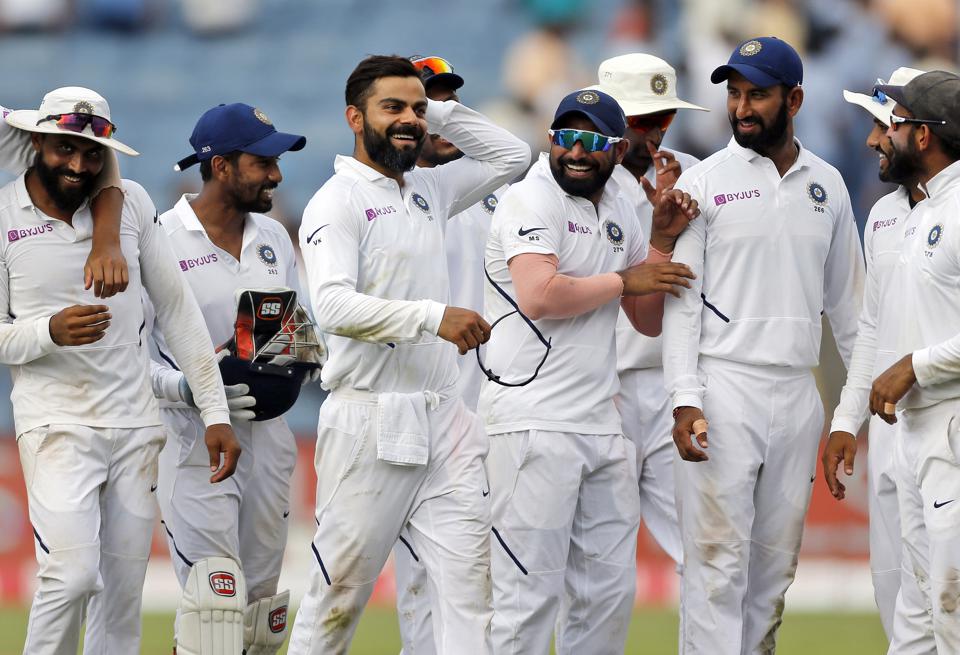The Gameplan | How India can target New Zealand's batting and win the World Test Championship final

After toiling for no less than 2 years, everything comes down to this for the Kohli-led Indian side: The World Test Championship final. Win it and they make history, lose it and the 24-month long toil will count for nothing. The two sides are evenly matched, but how exactly can India hurt the Kiwis?
Before we delve into the tactics, let’s get some generic information out of the way.
Where are India and New Zealand playing on Friday?
Rose Bowl, Southampton
What does India and New Zealand’s record at the venue look like?
India - P2 W0 L2
New Zealand - No Tests played at the venue
How have the two teams fared in England, of late?
India (since 2015): P5 W1 L4
New Zealand (since 2015): P4 W2 L1
The Kiwis, last week, became the first team in seven years to win a series in England.
What happened the last time India met New Zealand in Test cricket?
Welp, the Kiwis won 2-0. It was played in New Zealand, yes, but each of the two Tests finished in under four days.
Okay, the aforementioned information suggests that the Kiwis will enter the one-off final not just as favorites, but arguably strong favorites. They also, unlike India, have had ideal match-practice heading into the final, having played two Tests in the country. So what is this game-plan and why do we think India stand a chance?
Why India stand a chance
It is true that the odds are stacked in favour of New Zealand. But it is worth noting that the Kiwis made the WTC final solely based on their home dominance. In the WTC cycle, New Zealand astonishingly won a solitary away match. They were blanked 3-0 by an Aussie side that was later embarrassed 2-1 by a third string Indian side, and they only made the final in the first place owing to the pandemic-induced ‘percentage of points’ rule change. So while the 1-0 victory against England undoubtedly was impressive, there is little that suggests that this New Zealand side is one that’s impregnable. And, uhhh, mind you, this is again a side that is notorious for dropping the ball in big matches, having NEVER won an ICC Trophy to date. Their pressure-handling has been questionable, so back them at your own risk.
The Gameplan
New Zealand have a world-class bowling attack that has always delivered under pressure, even at the worst of times, and a deceptively world-class batting line-up that has been skating on thin ice for quite a while. So yes, you guessed it right - the first two points - revolve around how India can get a strangle-hold on the contest by bringing the Kiwi batting to its knees.
Ploy 1: Torment the Top 6 with Ashwin
Post India’s 2-1 triumph Down Under, everyone in this universe not named Sanjay Manjrekar understood and realized the importance and excellence of Ravichandran Ashwin, and he will enter the WTC Final as Virat Kohli’s trump card.
Ashwin is very, very good against any batsman, but give him a left-hander and he’ll strip his man naked. In his career, the off-spinner averages 19.3 against left-hand bats (compared to his overall average of 24.69) and this figure has dropped down to a mere 9.4 since the start of 2020. Chuck that, no one in the history of this sport has dismissed left-handers more than Ashwin. Not even Muttiah Muralitharan.
And it happens so that the Kiwis have 3 batsmen in the Top 5 who are left-handers. One of whom (Henry Nicholls) has averaged 13.1 against off-spinners since 2019, being dismissed by finger-spinners 10 times in this period. Yes, most recently by Joe Root too. So Ashwin ‘IS’ dismissing Nicholls; that is inevitable.
And while we don’t have enough info on Devon Conway, yet, we do know that the last time this Kiwi line-up came up against a decent off-spinner (Nathan Lyon, in case you’re wondering), they fared like third-graders against express pace. Lyon, in 2019/20 against the Kiwis, averaged a mere 17.25 and ended as the highest wicket-taker in the series with 20 wickets, taking 5 more than any other Aussie bowler. New Zealand’s skipper and supposed best-player-of-spin averaged 10.00 in the series against Lyon, who himself was out-bowled and embarrassed by Ashwin in Australia’s very next series.
Thus the key for India will be to utilize Ashwin as an attacking option, just like they did in Australia. Notwithstanding the nature of the Southampton wicket, Ashwin has a psychological edge over the Kiwi batters heading into the one-off game, and it would be prudent on India’s part to exploit the same to the fullest. After all, if Lyon can run through this Kiwi unit in Perth, there is no reason why Ashwin cannot do the same on an Ageas Bowl wicket that is expected to assist spin.
Ploy 2: Try everything possible to send the openers back to the hut early; expose the brittle middle-order
On paper, a middle-order of WIlliamson, Taylor, Nicholls and Watling is a dream quartet: not only are they versatile and experienced, but they also have the numbers to back up their excellence. Prior to the England series, in the WTC cycle, together the middle-order averaged an astonishing 61.86, led by their skipper who struck two double tons. But there is a catch.
To put it bluntly, take the luxury of home away from the four and they are, ummm, ordinary. Since the start of the first WTC cycle, the New Zealand middle-order (#3 to #6) has averaged a mere 25.93 in matches away from home; this figure read 29.30 in the 1-0 triumph against England last week. Barring BJ Watling (whose figures are also, mind you, inflated by a 105* against SL), all of Taylor, Nicholls and Williamson have averaged under 33 away from home in Test cricket in the past 18 months, with the skipper’s numbers reading a hideous 10.55. So there’s a clear weakness here to be exploited.
But the challenge for India will be to get to this weakness, for which they’ll have to breach the openers. And as we witnessed in the England series, with Conway now integrated into the side, removing the Kiwi openers is no mean feat.
So how can they do it?
Tom Latham: Latham, as we all know, is a solid customer, and has averaged close to 37 away from home in the past 18 months. But as we witnessed against England, he has his fair share of troubles. The southpaw is susceptible against inswing, deliveries from round the wicket and a combination of the two.
Versus pace against deliveries bowled from round the wicket, Latham averages a mere 32.12 in stark comparison to 50.25 from over the wicket. And, likewise, against right-arm bowlers from round the wicket, he averages a mere 15.00 against inswinging deliveries, compared to 28.33 against outswingers. Twice against England the New Zealand vice-captain was pinned on the crease - from round the wicket - by Stuart Broad, who used the simple trick of bringing the ball back into the southpaw.
All four pacers in contention to play for India - Bumrah, Siraj, Shami and Ishant - are adept at bowling from the round the wicket, but Shami might just be Kohli and Co’s best bet against Latham. Versus left-handers, Shami not only is a master at bringing LBW and bowled into play, but an expert in doing so from round the wicket. Case in point, Latham’s dismissal in the first innings in Christchurch last year, when Shami nipped one back and rattled the southpaw’s off-stump. Interestingly, all 3 Latham dismissals in that series were from round the wicket.
Devon Conway: Alright, let’s be honest. At this point in time Conway has no weakness, and hardly anyone has a clue as to how to dismiss him cheaply. But the newcomer did expose a slight (very slight) chink in his armor at Lord’s.
On debut Conway struck 223 runs across two innings, but it did not come without luck. The opener inside-edged the ball an astonishing 25 times, and notably chopped on in the second innings, in which he was conciscoulsy aiming to be proactive. This was, in part, due to his inherent tendency to attack, with him leaving just 19% of his deliveries in that double-ton. To put this figure into perspective, the average leave percentage for openers in England is 29%.
So what can India infer from this? Two things: one, Conway loves to drive and two, he hates to leave.
How they can tempt him into driving - which will bring both the inside and outside edge into play - is by deploying Mohammed Siraj from over the wicket. Siraj, who, mind you, is not a lock for the WTC final, is a master at slanting the ball away from the left-hander from over the wicket, and made life difficult for all of Warner, Harris, Wade and Head through the tactic. He also, unlike an Ishant, bowls more fully naturally, thereby increasing the chances of a chop-on or an outside edge. Thus a viable plan against Conway (who is pretty strong off his backfoot) could be to tempt him via Siraj.
Another effective tactic which could work against the newcomer could be to rough him up and test him with short stuff. Wood, though not getting the better of Conway, did manage to rattle the southpaw with the bumpers: at Lord’s Conway played 33% false shots against balls shorter than 9m. The only express pace bowler India have up their sleeve is Jasprit Bumrah, but his accuracy dwarfing that of Wood means that Conway, who looked in discomfort against the bumpers in his first Test series, will have a hard time negating the right-armer.
The key for India here, though, will be to be proactive with the change in tactics, and not let Conway settle. England were guilty of being too passive, and a repetition of the same will spell trouble for the Indians.
Other key pointers
1) India will need to be wary of the fact that, unlike in Australia, Pujara’s block-and-bore tactic might not be too effective in England. Unlike the Kookaburra, the Dukes still provides help aplenty for seamers post the first 30 overs and the same was evident in the first innings of Edgbaston where the Kiwis ran riot with a seemingly old cherry. This is not to say that Pujara will need to up his scoring rate, but, rather, Pujara spending time at the middle will not make life easy for the rest of the batters below him.
2) The Indian lower-order should aim to exploit the Kiwis’ woes against the tail. Since the pandemic restart, lower order of teams (7th wicket partnership and lower) have averaged 23.90 against New Zealand, 3 more than the global average of 20.76. The English lower order, even in the absence of Chris Woakes, Sam Curran and Moeen Ali, averaged 26.16 against the Kiwis, with all of Wood, Robinson and Stone frustrating the Blackcaps at different points in the series. Playing both Jadeja and Ashwin will certainly add more depth to the batting, and so there could be an avenue for India to hurt the Kiwis using lower-order runs.
3) Kohli needs to be wary of not over-bowling Bumrah with the new-ball. Astonishingly, Bumrah, in his Test career, for reasons unknown, has not been the greatest of operators with the new cherry: versus AUS, SA, NZ and ENG, the right-armer has averaged 42.9 with the new ball (0-15 overs), most of which have come in his first spell. However, this number reduces to 21.4 post the 15-over mark, during which he has taken 72% (60 of 83) of his Test wickets. With the dukes ball set to provide assistance for the pacers well into the second and third sessions, utilizing Bumrah minimally up-front, and unleashing him as the ball gets older, might enable India to get the best out of the right-armer.




Comments
Sign up or log in to your account to leave comments and reactions
0 Comments